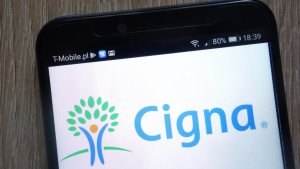With the aging Baby Boomer population bringing forth the demand for more ongoing care, questions linger. How will major health insurance firms meet growing needs without hurting their medical loss ratios or MCLs, which have already been on the loftier side over the past year.
At this juncture, the broad basket of managed care stocks is experiencing more than its fair share of turbulence. However, that comes with some pretty decent valuations across the board. Let’s tune into three dirt-cheap health plays as they try to turn a corner.
UnitedHealth Group (UNH)

Founded in 1977, UnitedHealth Group (NYSE:UNH) was one of the managed care companies caught up in the wide-scale cyberattack this year. Recently, the firm announced it paid a ransom to cyber attackers in an effort to protect its compromised patients’ data. The amount paid was not disclosed. The good news is that the attack has not caused a downgrade to the year’s earnings guidance.
As the company moves on from the major data breach, the firm faces a different slate of challenges as it looks to finish what’s been a rather rough start to the year on a high note. Year-to-date (YTD), UNH stock is still down around 8%. And that’s after the recent post-earnings spike on the back of some pretty impressive first-quarter results.
For the first quarter, the firm beat on the top and bottom lines. Adjusted earnings per share came in at $6.91, beating expectations of $6.61. Revenue of $99.2 billion edged slightly past estimates. The MLR was a hair higher than expected but was certainly far better than feared, given the unfortunate circumstances with the breach and other industry-wide woes.
It’ll be interesting to see if the $454 billion healthcare behemoth can break out for investors. I think it can, as it reports against some pretty modest and muted expectations going into the year’s end.
Humana (HUM)

Already having a brutal 2024, Humana (NYSE:HUM) shares are down close to 34% YTD. And down nearly 44% from its 2022 all-time high, HUM looks far too cheap for its own good.
Unlike UnitedHealth, Humana’s latest round of good quarterly earnings couldn’t help it reverse recent negative momentum. Being forced to lower full-year earnings per share guidance will do that. Indeed, Humana seems to be feeling the industry headwinds just a bit harder than its peers. The company’s MLR swelled by more than 3% year-over-year (YOY), a figure Wall Street already anticipated.
As management hopes to beef up margins, perhaps HUM stock may be able to pole-vault over what I view as some pretty depressed expectations. At 19.3 times forward price-to-earnings (P/E), I think there’s great value to be had on this dip.
Cigna (CI)

Cigna (NYSE:CI) gets an A-grade for navigating last year’s industry-wide storm of headwinds. The firm shows us all that not all industry players are created equal.
Despite the rough patch experienced last year, CI stock is close to new all-time highs at around $350 per share. It has a respectable 14.3% in YTD gains and strength in specialty pharmacy. So, Cigna may just be able to make the most of an otherwise rough industry-wide situation.
Recently, Jefferies analyst David Windley released a note suggesting that Cigna may wish to give Humana a second look now that the valuation gap has widened a bit. He thinks the “math now works” for such an epic merger deal.
Only time will tell if it actually sees the light of day. Regardless, as HUM stock sinks while CI stock continues marching higher, I’d argue the odds of such a deal only stand to increase. Either way, CI stock looks so incredibly cheap at 12.5 times forward P/E.
On the date of publication, Joey Frenette did not hold (either directly or indirectly) any positions in the securities mentioned in this article. The opinions expressed in this article are those of the writer, subject to the InvestorPlace.com Publishing Guidelines.
Joey Frenette is a seasoned investment writer specializing in technology and consumer stocks. Contributing to the Motley Fool Canada, TipRanks, and Barchart, Joey excels in spotting mispriced stocks with long-term growth potential in a fast-paced market.
